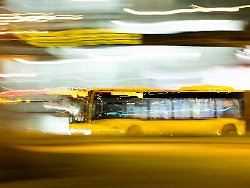Tuesday, November 02, 2021
Fuel and corona drive prices up
Bus and train are becoming much more expensive in some cases
In many places, customers have to be prepared for higher ticket prices in local transport. The providers pass on some of the increased prices for fuel and electricity. But Corona, the expansion of the range and digitization are also driving prices. However, some customers can breathe a sigh of relief.
It is not just fuel and food that are becoming more expensive. Many people in Germany will soon have to pay extra for bus and train travel. In winter, prices rise not only in long-distance transport, but also in local transport in numerous regions. As a result, many daily trips are sometimes significantly more expensive: Depending on the transport association, the average tariff increases by up to 5.5 percent. This emerges from resolutions on the upcoming price round at the turn of the year.
Elsewhere, on the other hand, prices do not change at all. As the last of the large associations, the Hamburger Verkehrsverbund is working on a price increase. The Hanseatic population is expected to pay an average of 1.3 percent more from the turn of the year. “Nobody is happy about that,” confesses the association. “Please keep in mind when discussing: Everything will be more expensive.” Only part of the higher costs are passed on to the passengers. The tax office takes over the much larger part.
Fuel, electricity, new offers – in many regions these are the main arguments for higher prices. The slump in fare income is putting the 135 member companies in dire straits, according to the transport association for the greater Nuremberg area. In addition, the traffic turnaround away from the car must be financed, as well as new digital offers.
Stable prices in Berlin and Bremen
Bus and train travel will be considerably more expensive for the Franks. In the VGN, the tariffs are rising for the first time in three years and therefore by an average of 5.5 percent. Only in the city of Nuremberg itself do millions from the city coffers ensure that the tariffs can once again remain stable.
In Munich and the surrounding area, too, it will be significantly more expensive: an increase of 3.7 percent will apply from mid-December. “The corona pandemic brought us enormous revenue shortfalls,” explained the local transport association. Nevertheless, the offer was almost completely maintained. In Stuttgart and the surrounding area it will be 2.5 percent more expensive. In the Verkehrsverbund Rhein-Ruhr, the most populous in Germany, the tariffs rise somewhat more slowly at 1.7 percent. It is 1.5 percent in the neighboring Rhein-Sieg- and Rhein-Main-Verkehrsverbund, which includes large parts of Hesse. For trips outside of associations, Deutsche Bahn had announced a tariff surcharge of 1.7 percent.
But passengers don’t have to dig deeper into their pockets everywhere. Nothing will change in Bremen, its environs in Lower Saxony, Berlin and Brandenburg. Bremer can even look forward to the second clear round in a row. These transport associations cite an argument that others expressly use for price increases: the decrease in passengers in the corona pandemic. They want to get customers back on buses and trains with stable prices.
